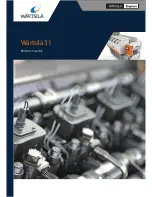
EB-10X Installation & Service Manual |
Wiring
7 Kollmorgen | kdn.kollmorgen.com | October 2020
2
WIRING
Install this motor and typical amplifier per the national electrical
code
.
To adhere to suitable engineering practices, connect the 115 VAC circuit so the 115 VAC is
applied first to activate the control and fault circuits before applying the main bus voltage.
Provide over-current protection, based on continuous rated current, per article 430 of the
NEC. If possible, adjust the amplifier accordingly. Otherwise, provide external protection.
The method of connecting the motor is by way of flying leads; where the leads of the 3-phase
motor stator are color coded and are available directly out of the motor.
Connect the motor with flying leads, where the leads of the 3-phase motor stator are color-
coded and available directly out of the motor. See the wiring diagrams for the correct method
of wiring the motor stator. Connect the BROWN, RED, and WHITE leads to the points
identified as M
a
, M
b
, and M
c
on the power terminal block. Connect the green/yellow lead to
the ground point of the ground point of the same terminal block.
Bring the 3-phase 230 input power should be brought through a customer supplied circuit
breaker and connected to points identified as La, Lb and Lc on the power terminal block
mounted on the power supply. The system is not AC line phase sensitive. Connect the 325
VDC output, the 115 VAC, and the regeneration circuit from the power supply to the amplifier
with the strapping bars and the small 115 VAC and regen cable. Check to ensure that the
small cable is connected to the correct pins and that it is not offset to one side, and do the
following:
1. Wire the typical amplifier control terminal strips per the diagram. Dress the wiring neatly
so it does not to interfere with remounting the cover.
2. Unplug the C1, C2 and C3 point terminal strips from their connectors on the amplifier-
motor control board. This will prevent over flexing the board when wiring up the
connectors.
3. After unplugging the terminal strips from the motor control board, wire them per the
appropriate diagram.
4. Neatly dress the wire cable so that it enters the amplifier chassis and does not interfere
with the front cover. Dress signal cables separately and not with the AC or power wiring.
5. Leave sufficient length in the wiring to allow the motor control board to slide out enough
to expose the small compensation board. Insert the wired terminal strips back onto their
connectors.
The following precautions are also recommended:
1. Twist all AC leads to minimize electromagnetic emissions and pick-up. Maintain shield
over resolver leads.
2. Avoid running signal leads in close proximity to power leads, armature leads or other
sources of electromagnetic noise.
3. Minimize lead lengths as much as practical.
4. Double-check all interface wiring. Carefully inspect all connections.
5. Do not use main contactor for control functions.
Motor and resolver phasing are critical for proper operation.








































